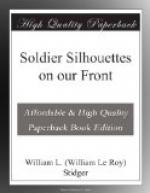VI
SILHOUETTES OF SILENCE
Two o’clock in the morning on the sea is sometimes cold and disagreeable, and sometimes it is glorious with wonder and beauty. But whether it is beautiful or whether it is cold and disagreeable, at that exact hour in the war zone on every American transport, now, every boy is summoned on deck until daylight. This is only one of the many precautions that the navy is taking to save life in case of a U-boat attack. One thing that ought to comfort every mother and father in America is the care that is manifested and the precautions that are taken by the navy in getting the soldiers to France. One of the most thrilling chapters of the history of this war, when it is written, will be that chapter. And one of the most wonderful, the most colossal feats will be the safe transportation overseas of those millions of soldiers with so little loss of life while doing it.
And one of the best precautions is this of getting every boy up out of the hold and out of the staterooms, officers and all, on deck, standing by the assigned life-boats and rafts. Not a single boy remains below in the war zone.
Day is just breaking across the sea. It is a beautiful dawning. Five thousand American boys line the railings of a certain great transport. They are not allowed to smoke. They do not sing. They do not talk much. Some of them are sleepy, for the average American boy is not used to being awakened at two in the morning. They just stand and wait and watch through five hours of silence as the great ship plunges its way defiantly through the danger zone, saying in so many words: “We’re ready for you!”
And the silhouette of that great ship, lined with khaki-clad American boys, waiting, watching, as seen from another transport, where the watcher who writes this story stands, is a sight never to be equalled in art or story. To see the huge bulk of a great transport just a stone’s throw away, moving forward, without a sound from its rail-lined, soldier-packed deck, is one of the striking Silhouettes of Silence.
Thomas Carlyle once said of man: “Stands he not thereby in the centre of Immensities, in the conflux of Eternities?” One day I saw the American army standing “in the centre of immensities, in the conflux of eternities,” at the focus of histories. One day I saw the American army in France march in answer to General Pershing’s offer to the Allies at the beginning of the big drive, march to its place in history beside its Allies, the English and the French.
The news came. The first division of American troops was to leave overnight and march overland into the Marne line. Our Allies needed us. They had called. We were answering.




